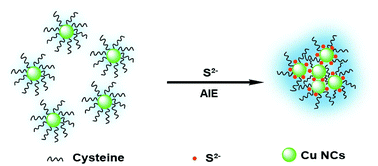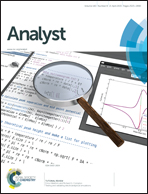A highly selective fluorescent probe for sulfide ions based on aggregation of Cu nanocluster induced emission enhancement†
Abstract
In this study, S2− ions were found to enhance the fluorescence of cysteine-capped Cu nanoclusters (Cu NCs). High resolution transmission electron microscopy (HRTEM), Fourier-transform infrared spectroscopy (FT-IR), scanning electron microscopy-energy dispersive X-ray (SEM-EDX) measurements, zeta potential and X-ray photoelectron spectroscopy (XPS) measurements demonstrated that the S2− ion-induced aggregation of the Cu NCs contributed to the fluorescence enhancement of the dispersed Cu NCs. Based on these findings, a highly selective fluorescent probe was developed for the determination of H2S using the S2− ion-enhanced fluorescence of the as-prepared Cu NCs. The relative fluorescence intensity was proportional to the concentration of S2− in the range from 0.2 to 50 μM. The detection limit (S/N = 3) was 42 nM. The proposed method has been successfully applied to determine H2S produced from toys called “Fart Bomb” with recoveries of 97.6–101.8%. The results of the proposed method were in good agreement with those determined by a standard methylene blue method. This work is not only of importance for a better understanding of the aggregation induced emission (AIE) properties of the Cu NCs but also of great potential to find extensive biological applications for H2S.


 Please wait while we load your content...
Please wait while we load your content...